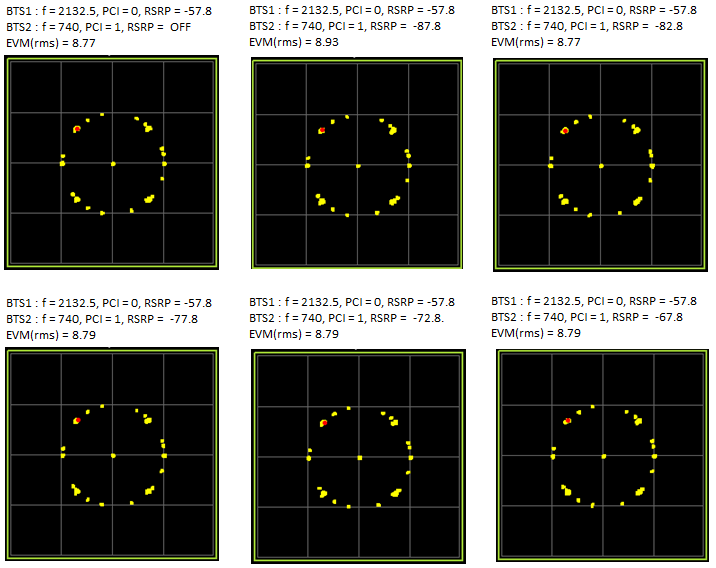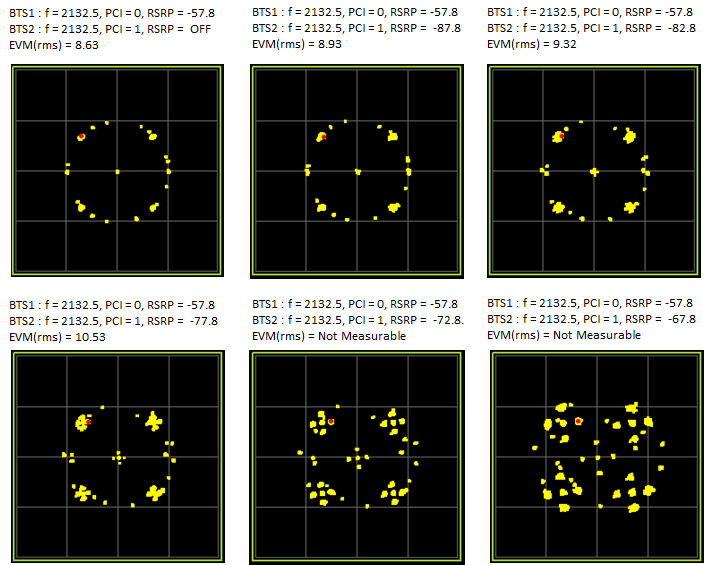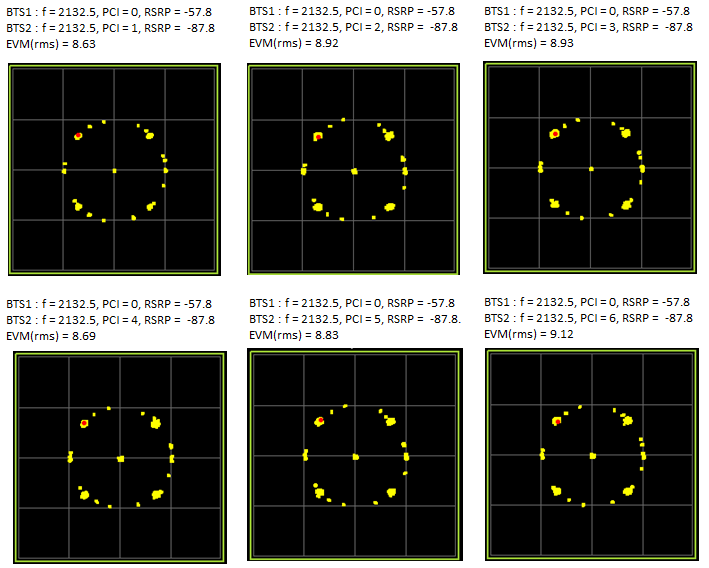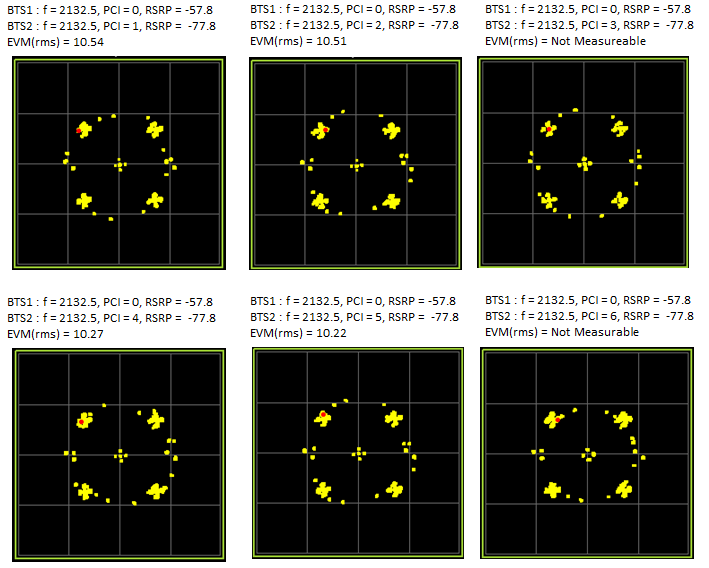|
4G/LTE - Interference |
||
|
Downlink Interference
I want to talk a little bit about Interference between multi cells (Inter Cell Interference). In this page, I will show you some of the measurement result but don't pay too much attention to the exact measurement values. You would get different value in different situations or the value shown here would be different from the value measured by UE in live network. But general trend and characteristics of the interence would apply to most of the cases. You should be well aware of this kind of properties especially if you are working on test cases related to various mobility issues (Cell Selection, Reselection, Measurement Report, Handover, Redirection etc).
Followings are the general characteristics (tendencies) in intercell interference.
< When the Interference come into play ? >
Now the question is When we have to take this interference seriously ?. The general answer is 'Always'. We have to take precautions anytime and as much as possible. I think The most crucial situation is at cell detection/selection/reselection stage because it would be the worst case if you power on the mobile phone and it fail to detect any cell due to the interference. To understand on possibile mode of interference, you need to know the detailed procedure/factors for this process. Following is what's happenning when you power on UE. i) Frequency Aquisition ii) Primary Sync Signal Aquisition (Slot Timing Aquired, Secondary Sync Signal Scrambling Code Aquired) iii) Secondary Sync Signal Aquisition (Frame timing Aquired, Cell Group ID sequence aquired) iv) with PSS and SSS, Cell ID can be calculated v) with Cell ID, Reference Signal Location is detected vi) With the help of Reference Signal, PBCH (MIB) can be detected vii) From MIB, SFN and System BW can be detected viii) Decode PCFICH and detect how many symbols are allocated for PDCCH. ix) Decode DCI for SIB1 from PDCCH x) Decode SIB1 and get the scheduling information for other SIBs xi) Decode SIBs (other than SIB1) Now let's think of each of the steps and what might be the issues with those steps in terms of interference.
i) Frequency Aquisition ii) Primary Sync Signal Aquisition (Slot Timing Aquired, Secondary Sync Signal Scrambling Code Aquired) iii) Secondary Sync Signal Aquisition (Frame timing Aquired, Cell Group ID sequence aquired) iv) with PSS and SSS, Cell ID can be calculated v) with Cell ID, Reference Signal Location is detected vi) With the help of Reference Signal, PBCH (MIB) can be detected vii) From MIB, SFN and System BW can be detected viii) Decode PCFICH and detect how many symbols are allocated for PDCCH. ix) Decode DCI for SIB1 from PDCCH x) Decode SIB1 and get the scheduling information for other SIBs xi) Decode SIBs (other than SIB1)
< Inter Frequency Interference between LTE and LTE with Varying Channel Power >
In this example, I setup two cells with different band (Inter frequency, Inter band) as follows. I used BTS1 as a serving cell and BTS2 as a neighbouring interfering cell. and I used a Vector signal analyzer as a kind of DUT and measured EVM (Error Vector Magnitude) detected by the serving cell.
As you see in the result shown below, there is almost no difference in the measured EVM at BTS1 regardless of the power of interfering cell. (In this example, the frequency of two cell is very far away from each other, so interference from the other cell is negligible, if the fequency of neighbouring cell is closer to each other, you would see stronger interference than in this example).
< Intra Frequency Interference between LTE and LTE with Varying Channel Power >
In this example, I setup two cells with same frequency (Intra frequency) as follows. I used BTS1 as a serving cell and BTS2 as a neighbouring interfering cell. and I used a Vector signal analyzer as a kind of DUT and measured EVM (Error Vector Magnitude) detected by the serving cell. I set the BTS1 power to be fixed and increased the power of BTS2 step by step and checked how the measurement EVM varies.
Just by looking at the constellation, you can intuitively notice that EVM gets larger (constellation gets worse) as the interferering cell power gets higher. The EVM result shown here is a little extreme case. According to this result, the DUT (Vector signal Analyzer) fail to decode the signal if the cell power difference between two cell is less than 20. But in live network, the situation would be much better than this. Isolation between the two cell would be much better than this test environment and real UE (mobile phone) can decode signal much which is much worse than this since the chipset has channel estimation and use various error correction. However the point is that UE would experience pretty serious interference when it seems multiple cells with the same frequency around the UE. You can see obvious difference (outstanding difference) if you compare this result with the previous case (Inter frequency case).
< Intra Frequency Interference between LTE and LTE with Varying Physical Cell ID (PCI) >
In this example, I setup two cells with same frequency (Intra frequency) as follows. I used BTS1 as a serving cell and BTS2 as a neighbouring interfering cell. and I used a Vector signal analyzer as a kind of DUT and measured EVM (Error Vector Magnitude) detected by the serving cell.
I set the PCI of BTS1 to be fixed and changed PCI of BTS2 to various different values to how the measured EVM changes. This is to check how the location of reference signal of the serving cell and neigbhouring cell can influence on the interference (If you are not sure about how PCI is related to Reference Signal location, refer to Downlink Reference Signal page)
As shown in the following result, when there is almost no inteference between two cells when the cell power of the two different cell is very large.
But the cell power difference between two cells is relatively small (actually this difference in this example is still very big difference in live network), you would see the DUT (Signal Analyzer) fails to measure signal when the PCI is configured in such a way that the reference signal of the two cells are same.
|
||



